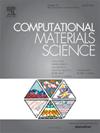First-principles insights into the site occupancy of Ta–Fe–Al C14 laves phases
IF 3.3
3区 材料科学
Q2 MATERIALS SCIENCE, MULTIDISCIPLINARY
引用次数: 0
Abstract
This study investigates the site occupancy preferences of Al in Ta(FeAl) Laves phases using first-principles calculations, covering Al concentrations from 0 to 50 at.%. Al atoms exhibit a strong preference for Wyckoff sites, with configurations becoming more energetically favorable as these sites reach full occupancy at high Al concentrations. Magnetic configurations were explored, revealing that anti-ferromagnetic ordering is the most favorable at ground states. A metastable defect phase diagram based on the chemical potential of Al was constructed to map site occupancy preferences, where TaFeAl and TaFeAl exhibit the widest chemical potential windows. The correlation between lattice distortions and site occupancy was examined, demonstrating that symmetric Al distributions enhance structural preference. These findings offer insights into the structural motifs of the Ta–Fe–Al system, providing a foundation for future investigations on structure–property relationships.

Ta-Fe-Al - C14叶相占位的第一性原理研究
本研究利用第一性原理计算研究了Al在Ta(Fe1−xAlx)2 Laves相中的位置占位偏好,涵盖了Al浓度从0到50 at.%。Al原子表现出对2a Wyckoff位的强烈偏好,当这些位在高Al浓度下达到满员时,构型变得更加有利于能量。研究了磁结构,揭示了在基态下反铁磁有序是最有利的。构建了基于Al化学势的亚稳缺陷相图来绘制位点占用偏好,其中Ta4Fe6Al2和Ta4Fe2Al6具有最宽的化学势窗口。研究了晶格畸变和位置占用之间的关系,表明对称的Al分布增强了结构偏好。这些发现提供了对Ta-Fe-Al体系结构基序的见解,为未来研究结构-性质关系提供了基础。
本文章由计算机程序翻译,如有差异,请以英文原文为准。
求助全文
约1分钟内获得全文
求助全文
来源期刊

Computational Materials Science
工程技术-材料科学:综合
CiteScore
6.50
自引率
6.10%
发文量
665
审稿时长
26 days
期刊介绍:
The goal of Computational Materials Science is to report on results that provide new or unique insights into, or significantly expand our understanding of, the properties of materials or phenomena associated with their design, synthesis, processing, characterization, and utilization. To be relevant to the journal, the results should be applied or applicable to specific material systems that are discussed within the submission.
 求助内容:
求助内容: 应助结果提醒方式:
应助结果提醒方式:


